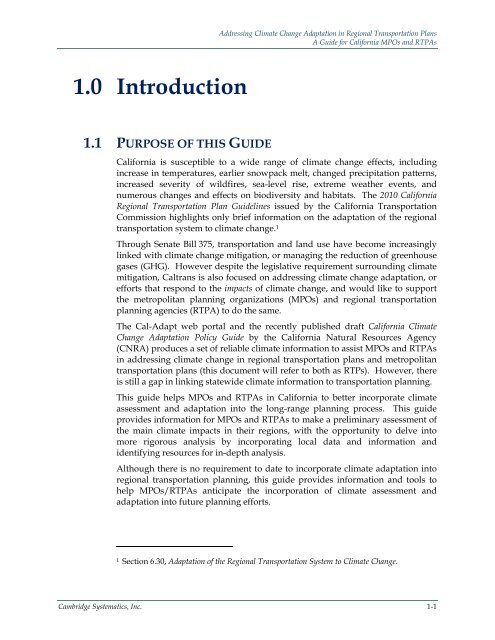addressing climate change adaptation in regional transportation plans
addressing climate change adaptation in regional transportation plans addressing climate change adaptation in regional transportation plans
Addressing Climate Change Adaptation in Regional Transportation PlansA Guide for California MPOs and RTPAs1.0 Introduction1.1 PURPOSE OF THIS GUIDECalifornia is susceptible to a wide range of climate change effects, includingincrease in temperatures, earlier snowpack melt, changed precipitation patterns,increased severity of wildfires, sea-level rise, extreme weather events, andnumerous changes and effects on biodiversity and habitats. The 2010 CaliforniaRegional Transportation Plan Guidelines issued by the California TransportationCommission highlights only brief information on the adaptation of the regionaltransportation system to climate change. 1Through Senate Bill 375, transportation and land use have become increasinglylinked with climate change mitigation, or managing the reduction of greenhousegases (GHG). However despite the legislative requirement surrounding climatemitigation, Caltrans is also focused on addressing climate change adaptation, orefforts that respond to the impacts of climate change, and would like to supportthe metropolitan planning organizations (MPOs) and regional transportationplanning agencies (RTPA) to do the same.The Cal-Adapt web portal and the recently published draft California ClimateChange Adaptation Policy Guide by the California Natural Resources Agency(CNRA) produces a set of reliable climate information to assist MPOs and RTPAsin addressing climate change in regional transportation plans and metropolitantransportation plans (this document will refer to both as RTPs). However, thereis still a gap in linking statewide climate information to transportation planning.This guide helps MPOs and RTPAs in California to better incorporate climateassessment and adaptation into the long-range planning process. This guideprovides information for MPOs and RTPAs to make a preliminary assessment ofthe main climate impacts in their regions, with the opportunity to delve intomore rigorous analysis by incorporating local data and information andidentifying resources for in-depth analysis.Although there is no requirement to date to incorporate climate adaptation intoregional transportation planning, this guide provides information and tools tohelp MPOs/RTPAs anticipate the incorporation of climate assessment andadaptation into future planning efforts.1 Section 6.30, Adaptation of the Regional Transportation System to Climate Change.Cambridge Systematics, Inc. 1-1
- Page 1: Addressing Climate Change Adaptatio
- Page 7: Addressing Climate Change Adaptatio
- Page 13 and 14: Addressing Climate Change Adaptatio
- Page 15: Addressing Climate Change Adaptatio
- Page 21 and 22: Addressing Climate Change Adaptatio
- Page 23 and 24: Addressing Climate Change Adaptatio
- Page 25 and 26: Addressing Climate Change Adaptatio
- Page 27 and 28: Addressing Climate Change Adaptatio
- Page 29 and 30: Addressing Climate Change Adaptatio
- Page 31 and 32: Addressing Climate Change Adaptatio
- Page 33: Addressing Climate Change Adaptatio
- Page 36 and 37: Addressing Climate Change Adaptatio
- Page 38 and 39: Addressing Climate Change Adaptatio
- Page 40 and 41: Addressing Climate Change Adaptatio
- Page 42 and 43: Addressing Climate Change Adaptatio
- Page 44 and 45: Addressing Climate Change Adaptatio
- Page 46 and 47: Addressing Climate Change Adaptatio
- Page 49 and 50: Addressing Climate Change Adaptatio
- Page 51 and 52: Addressing Climate Change Adaptatio
- Page 53 and 54: Addressing Climate Change Adaptatio
- Page 55 and 56: Addressing Climate Change Adaptatio
- Page 57 and 58: Addressing Climate Change Adaptatio
- Page 59: PART II. A BASIC APPROACHFOR INCORP
- Page 62 and 63: Addressing Climate Change Adaptatio
- Page 64 and 65: Addressing Climate Change Adaptatio
Address<strong>in</strong>g Climate Change Adaptation <strong>in</strong> Regional Transportation PlansA Guide for California MPOs and RTPAs1.0 Introduction1.1 PURPOSE OF THIS GUIDECalifornia is susceptible to a wide range of <strong>climate</strong> <strong>change</strong> effects, <strong>in</strong>clud<strong>in</strong>g<strong>in</strong>crease <strong>in</strong> temperatures, earlier snowpack melt, <strong>change</strong>d precipitation patterns,<strong>in</strong>creased severity of wildfires, sea-level rise, extreme weather events, andnumerous <strong>change</strong>s and effects on biodiversity and habitats. The 2010 CaliforniaRegional Transportation Plan Guidel<strong>in</strong>es issued by the California TransportationCommission highlights only brief <strong>in</strong>formation on the <strong>adaptation</strong> of the <strong>regional</strong><strong>transportation</strong> system to <strong>climate</strong> <strong>change</strong>. 1Through Senate Bill 375, <strong>transportation</strong> and land use have become <strong>in</strong>creas<strong>in</strong>glyl<strong>in</strong>ked with <strong>climate</strong> <strong>change</strong> mitigation, or manag<strong>in</strong>g the reduction of greenhousegases (GHG). However despite the legislative requirement surround<strong>in</strong>g <strong>climate</strong>mitigation, Caltrans is also focused on <strong>address<strong>in</strong>g</strong> <strong>climate</strong> <strong>change</strong> <strong>adaptation</strong>, orefforts that respond to the impacts of <strong>climate</strong> <strong>change</strong>, and would like to supportthe metropolitan plann<strong>in</strong>g organizations (MPOs) and <strong>regional</strong> <strong>transportation</strong>plann<strong>in</strong>g agencies (RTPA) to do the same.The Cal-Adapt web portal and the recently published draft California ClimateChange Adaptation Policy Guide by the California Natural Resources Agency(CNRA) produces a set of reliable <strong>climate</strong> <strong>in</strong>formation to assist MPOs and RTPAs<strong>in</strong> <strong>address<strong>in</strong>g</strong> <strong>climate</strong> <strong>change</strong> <strong>in</strong> <strong>regional</strong> <strong>transportation</strong> <strong>plans</strong> and metropolitan<strong>transportation</strong> <strong>plans</strong> (this document will refer to both as RTPs). However, thereis still a gap <strong>in</strong> l<strong>in</strong>k<strong>in</strong>g statewide <strong>climate</strong> <strong>in</strong>formation to <strong>transportation</strong> plann<strong>in</strong>g.This guide helps MPOs and RTPAs <strong>in</strong> California to better <strong>in</strong>corporate <strong>climate</strong>assessment and <strong>adaptation</strong> <strong>in</strong>to the long-range plann<strong>in</strong>g process. This guideprovides <strong>in</strong>formation for MPOs and RTPAs to make a prelim<strong>in</strong>ary assessment ofthe ma<strong>in</strong> <strong>climate</strong> impacts <strong>in</strong> their regions, with the opportunity to delve <strong>in</strong>tomore rigorous analysis by <strong>in</strong>corporat<strong>in</strong>g local data and <strong>in</strong>formation andidentify<strong>in</strong>g resources for <strong>in</strong>-depth analysis.Although there is no requirement to date to <strong>in</strong>corporate <strong>climate</strong> <strong>adaptation</strong> <strong>in</strong>to<strong>regional</strong> <strong>transportation</strong> plann<strong>in</strong>g, this guide provides <strong>in</strong>formation and tools tohelp MPOs/RTPAs anticipate the <strong>in</strong>corporation of <strong>climate</strong> assessment and<strong>adaptation</strong> <strong>in</strong>to future plann<strong>in</strong>g efforts.1 Section 6.30, Adaptation of the Regional Transportation System to Climate Change.Cambridge Systematics, Inc. 1-1



